|
SARATOGA National Historical Park |
 |
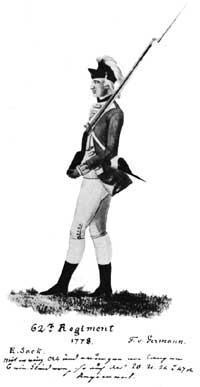 62nd British Regiment uniform: red coat (cut down), short black canvas gaiters, buff facings, waistcoat and breeches, white regimental lace with two blue and one yellow or straw-colored stripes. From an early print. |
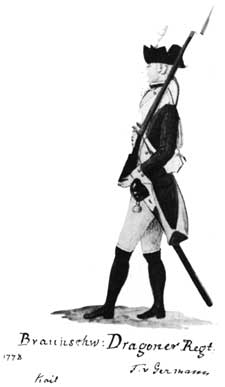 Brunswick Dragoon Regiment uniform: light blue coat with yellow facings and waistcoat, leather breeches. From an early print. |
Retreat and Surrender
An American force was already present on the east side of the Hudson, opposite Saratoga, thus blocking the crossing of the river. To continue the retreat northward in an effort to reach Fort Edward was now almost impossible for Burgoyne's weary and badly depleted army. In a few days he was completely surrounded on the heights of Saratoga by the American force which, by this time, had grown to about 20,000 men. Hopelessly outnumbered, provisions all but exhausted, and devoid of hope of help from the south, Burgoyne was forced to surrender on October 17, 1777.
The remnants of Burgoyne's army, probably numbering about 5,800 men, stacked their arms on the level flood plains along the banks of the Hudson near the ruins of Old Fort Hardy and became prisoners of war, according to the terms of the Convention of Saratoga drawn up between Gates and Burgoyne. By the terms of surrender, they were to be taken to Boston where they would board vessels to return to England. It was provided that they would not serve again in North America during the Revolutionary War. Burgoyne, by inducing Gates to sign this convention, almost succeeded in nullifying the great American victory at Saratoga. If the terms of the convention had been carried out, Burgoyne's army would have been available for service in Europe against the French, whom the Americans were at this time desperately endeavoring to induce to enter the war on the American side; or Burgoyne's army could have been used to relieve for service in America an equal number of British troops then garrisoning posts in other parts of the Empire, thus largely repairing, within 6 months' time, the damage to the British armies in North America. The Continental Congress therefore interposed first one obstacle and then another, and the terms of the convention were never kept. The captured soldiers were held in the North for about a year, and then most of them were sent to Charlottesville, Va., for the duration of the war. The majority of these prisoners remained in this country after the close of the war and were gradually absorbed among the populace of the new nation. Many American families today can trace their origin back to the British and German soldiers who surrendered at Saratoga.
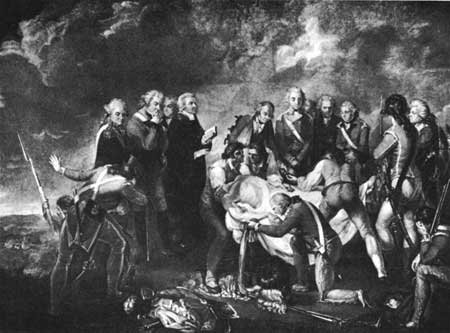
This old print, after the famous painting by John
Graham, portrays the burial of General Fraser. The English historian,
Fonblanque, has identified the portrait figures from left to right as:
Earl of Harrington, A.D.C.; General Burgoyne; Major-General Phillips;
Reverend Brudenell; Captain Green, A.D.C.; Lieutenant Colonel Kingston;
Major Fraser; Mr. Wood, Surgeon; Earl of Balcarres; Major General
Riedesel.
Courtesy Life Magazine.
The failure of the Burgoyne expedition, so auspiciously launched, may be attributed to a series of blunders and misfortunes climaxed by the heroic defense of a despised adversary. In his failure specifically to order Howe to cooperate with Burgoyne, the British Colonial Secretary, Lord George Germain, in the very beginning laid the basis for the campaign's fatal ending. Through carelessness, this order, though prepared, was apparently never mailed and was allowed to remain tucked away in a pigeonhole. To this costly blunder was added the refusal of Howe to cooperate in the northern expedition, despite the fact that he had been informed by Burgoyne and others of the expected nature of his participation. When advised by Howe of his proposed expedition against Philadelphia, Germain approved the plan but expressed the hope that it would be completed in time for cooperation with Burgoyne.
In persisting in the Philadelphia expedition against the advice of Clinton and other British officers who advised cooperation with Burgoyne, Howe preferred a plan of campaign which gained the British nothing to a plan which might well have won them the war. In his defense later, Howe argued that he had received no order to cooperate with the northern army; that he had warned Burgoyne not to expect aid from the south; that his move to Philadelphia had been approved by the King; and finally that he had advised Clinton to assist Burgoyne. This move of Clinton's however, came so late, and with such limited force, as to make it ineffective.
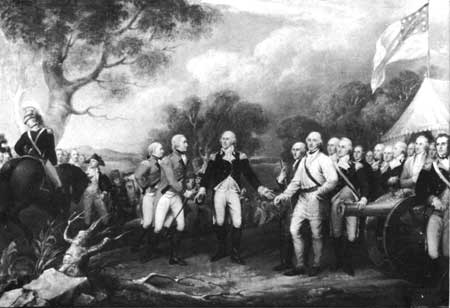
This famous painting of the surrender of General
Burgoyne at Saratoga, by John Trumbull, is of a memorial nature. It
does not attempt to reconstruct the actual scene. The four figures in
the central foreground are Generals Phillips, Burgoyne, and Gates, and
Colonel Morgan.
Courtesy Yale University Art
Gallery.
As if this were not enough, Burgoyne's position was still further weakened by the inability of St. Leger to create a proper diversion along the Mohawk. These blunders and misfortunes, inherently grave as they were, do not absolve Burgoyne altogether from responsibility for the failure of the northern campaign. His conduct of the campaign, at times, lacked forceful initiative and drive, to which were added grave errors of judgment, the most serious of which, in all probability, was the poorly planned expedition against Bennington. The imperative orders given to Burgoyne by British ministers in England, with little leeway to adjust his plans according to the actual course of events, was another important cause of the complete failure of the campaign. Sir Guy Carleton, then Governor of Canada, wrote in 1777: "This unfortunate event, it is to be hoped, will in the future prevent ministers from pretending to direct operations of war, in a country at three thousand miles distance, of which they have so little knowledge as not to be able to distinguish between good, bad, or interested advices, or to give positive orders in matters, which from their nature, at e ever upon the change; so that expedience or propriety of a measure at one moment, may be totally inexpedient or improper in the next."
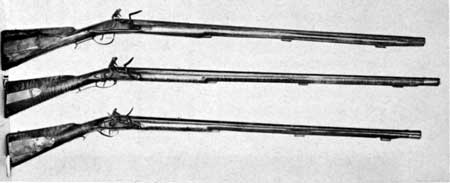
Three examples of the so-called Kentucky Rifle,
the type of weapon carried by most of Morgan's Corps of riflemen. These
rifled guns were much more accurate than the smooth-bore muskets used by
most of the soldiers on both sides during the American
Revolution.
In no small sense, however, the success of the American cause may be attributed to the skill of the colonial infantry who, under the daring leadership of Arnold and Morgan, had proved themselves more than a march for the British veterans. Furthermore, the American ability to increase their numbers within a short period of time materially added to their ultimate success. The speed with which the county and State governments called up the militia levies and forwarded the needed supplies enhanced the American position; so that as Burgoyne's manpower and supply situation became increasingly desperate, Gates' became stronger. Although most of the fighting at Saratoga was done by Continental troops, corresponding to what we would call regulars, the presence of the militia made possible the commitment to the battles of the better trained and organized Continentals.
The employment of Indians by the British and the outrages perpetrated by them upon the civilian populace, of which the murder of Jane McCrae was the most noted, helped to give a sense of urgency to the people of the region. This resulted in a greater degree of whole hearted support of the American military effort than might otherwise have been the case.
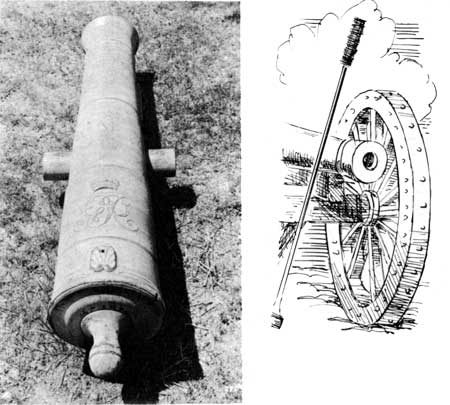
Burgoyne cannon. This 24-pounder bronze
gun was one of the pieces of artillery surrendered by the British at
Saratoga.

|

| History | Links to the Past | National Park Service | Search | Contact |
|
Last Modified: Mon, Dec 2 2002 10:00:00 am PDT |

